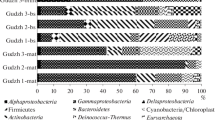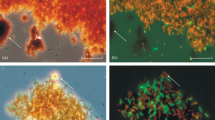Abstract
The phylogenetic diversity of archaea and bacteria was investigated for the first time in marl samples of the Verkhnekamsk salt deposit of Perm Krai (Russia). Two libraries of 16S rRNA genes from the marl sample (depth of 70.5 m) obtained by molecular genetic methods (cloning of 16S rRNA genes, RFLP analysis and sequencing) were distributed in 3 archaeal OTUs (80 clones) and 11 bacterial OTUs (86 clones). Phylogenetic analysis showed a low diversity of Archaea, closely related to the Thaumarchaeota phylum (phylogenetic cluster Marine Group I). Thereto, all archaeal OTUs were similar in the 16S rRNA gene with an uncultured archaeal clone isolated from groundwater of the Permian period. Molecular phylogeny revealed that bacterial diversity was presented by the phyla Proteobacteria, Actinobacteria and Acidobacteria. The dominant phylum Proteobacteria (75.54% of total bacterial clones) included 7 OTU, belonging to the classes Alpha-, Beta- and Gammaproteobacteria, most of which (44.19%) refer to the representatives of the genus Pseudomonas (class Gammaproteobacteria). Up to 12% of total bacterial clones may represent novel taxonomic units. This study indicated the occurrence and diversity of endolithic bacteria and archaea in the marls of the salt deposit, the presence of some of them was recorded for the first time in the saline endolithic microbial communities.
Access this chapter
Tax calculation will be finalised at checkout
Purchases are for personal use only
Similar content being viewed by others
References
Margesin, R., Schinner, F.: Potential of halotolerant and halophilic microorganisms for biotechnology. Extremophiles 5, 73–83 (2001)
Morozkina, E.V., Slutskaya, E.S., Fedorova, T.V.: Extremophilic microorganisms: biochemical adaptation and biotechnological application (review). Appl. Biochem. Microbiol. 46(1), 1–14 (2010)
Pallen, M., Telatin, A., Oren, A.: The next million names for archaea and bacteria. Trends Microbiol. 29(4), 289–298 (2021)
Edbeib, M.F., Wahab, R.A., Huyop, F.: Halophiles: biology, adaptation, and their role in decontamination of hypersaline environments. World J. Microbiol. Biotechnol. 32(8), 1–23 (2016). https://doi.org/10.1007/s11274-016-2081-9
Oren, A.: Microbial life at high salt concentrations: phylogenetic and metabolic diversity. Saline Syst. 4(2), 1–13 (2008)
Stan-Lotter, H., Gruber, C., Radax, Ch.: Halococcus dombrowskii sp. nov., an archaeal isolate from a Permian alpine salt deposit. Int. J. Syst. Evol. Microbiol. 52, 1807–1814 (2002)
Satterfield, C.L., Lowenstein, T.K., Vreeland, R.H.: New evidence for 250 Ma age of halotolerant bacterium from a Permian salt crystal. Geology 33(4), 265–268 (2005)
Korsakova, E.S., Anan’ina, L.N., Nazarov, A.V., et al.: Diversity of bacteria of the family Halomonadaceae at the mining area of the Verkhnekamsk salt deposit. Microbiology 82, 249–252 (2013)
Perri, E., Gindre-Chanu, L., Caruso, A., et al.: Microbial-mediated pre-salt carbonate deposition during the Messinian salinity crisis (Calcare di Base fm., Southern Italy). Mar. Pet. Geol. 88, 235–250 (2017)
Vreeland, R.H., Rosenzweig, W.D., Powers, D.W.: Isolation of a 250 million-year-old halotolerant bacterium from a primary salt crystal. Nature 407, 897–900 (2000)
Schubert, B.A., Lowenstein, T.K., Timofeeff, M.N., Parker, M.A.: How do prokaryotes survive in fluid inclusions in halite for 30 k.y.? Geology 37(12), 1059–1062 (2009)
Park, J.S., Vreeland, R.H., Cho, B.C., et al.: Haloarchaeal diversity in 23, 121 and 419 MYA salts. Geobiology 7, 515–523 (2009)
Gramain, A., Díaz, G.C., Demergasso, C., et al.: Archaeal diversity along a subterranean salt core from the Salar Grande (Chile). Environ. Microbiol. 13(8), 2105–2121 (2011)
Stan-Lotter, H., Fendrihan, S.: Halophilic archaea: life with desiccation, radiation and oligotrophy over geological times. Life 5, 1487–1496 (2015)
Jaakkola, S.T., Ravantti, J.J., Oksanen, H.M., Bamford, D.H.: Buried alive: microbes from ancient halite. Trends Microbiol. 24(2), 148–160 (2016)
Kashnikov, Y., Ermashov, A., Efimov, A.: Geological and geomechanical model of the Verkhnekamsk potash deposit site. J. Min. Inst. 237, 259–267 (2019)
Gubanova, E.A.: The influence of the deformation history on the location of rock destruction. Procedia Struct. Integr. 32, 42–48 (2021)
Hugenholtz, P., Goebel, B.M., Pace, N.R.: Impact of culture-independent studies on the emerging phylogenetic view of bacterial diversity. J. Bacteriol. 180(18), 4765–4774 (1998)
Mineev, V.G.: Practicum on Agricultural Chemistry, 2nd edn. Moscow University Press, Moscow (2001)
Bachurin, B.A., Odintsova, T.A., Khokhryakova, E.S.: Hydrocarbon markers of the organic matter of salts of the Verkhnekamsk deposit. Probl. Mineral. Petrography Metallogeny 19, 315–323 (2016)
ATCC Medium 2399: https://www.atcc.org/~/media/822926D3A28C441A92D1ACA8FE-9830CF.ashx. Accessed 29 Apr 2022
Medium data. https://www.jcm.riken.go.jp/cgi-bin/jcm/jcm_grmd?GRMD=168. Accessed 29 Apr 2022
Lane, D.J.: 16S/23S rRNA sequencing. In: Stackebrandt, E., Goodfellow, M. (eds.) Nucleic Acid Techniques in Bacterial Systematics, pp. 115–175. Wiley, New York (1991)
Grosskopf, R., Janssen, P.H., Liesack, W.: Diversity and structure of the methanogenic community in anoxic rice paddy soil microcosms as examined by cultivation and direct 16S rRNA gene sequence retrieval. Appl. Environ. Microbiol. 64(3), 960–969 (1998)
Delong, E.F.: Archaea in coastal marine environments. Proc. Natl. Acad. Sci. USA 89, 5685–5689 (1992)
Tamura, K., Stecher, G., Kumar, S.: MEGA11: molecular evolutionary genetics analysis version 11. Mol. Biol. Evol. 38(7), 3022–3027 (2021)
GenBank: https://www.ncbi.nlm.nih.gov/genbank. Accessed 29 Apr 2022
EzBioCloud: https://www.ezbiocloud.net/identify. Accessed 29 Apr 2022
Huber, T., Faulkner, G., Hugenholtz, P.: Bellerophon: a program to detect chimeric sequences in multiple sequence alignments. Bioinformatics 20(14), 2317–231910 (2004)
Raymond, R.L.: Microbial oxidation of n-paraffinic hydrocarbons. Dev. Ind. Microbiol. 2, 23–32 (1961)
Hong, Y., Youshao, W., Chen, F.: Archaea dominate ammonia oxidizers in the Permian water ecosystem of Midland Basin. Microbes Environ. 28(3), 396–399 (2013)
Hu, A., Jiao, N., Zhang, R., Yang, Z.: Niche partitioning of Marine Group I Crenarchaeota in the euphotic and upper mesopelagic zones of the East China Sea. Appl. Environ. Microbiol. 77, 7469–7478 (2011)
Pester, M., Schleper, C., Wagner, M.: The Thaumarchaeota: an emerging view of their phylogeny and ecophysiology. Curr. Opin. Microbiol. 14, 300–306 (2011)
Brochier-Armanet, C., Boussau, B., Gribaldo, S., Forterre, P.: Mesophilic crenarchaeota: proposal for a third archaeal phylum, the Thaumarchaeota. Nat. Rev. Microbiol. 6(3), 245–252 (2008)
Merkel, A.Y., et al.: Structure of the archaeal community in the Black Sea photic zone. Microbiology 84(4), 570–576 (2015). https://doi.org/10.1134/S0026261715040128
Lin, X., Kennedy, D., Fredrickson, J., et al.: Vertical stratification of subsurface microbial community composition across geological formations at the Hanford site. Environ. Microbiol. 14(2), 414–425 (2012)
Qin, W., Heal, K.R., Ramdasi, R., et al.: Nitrosopumilus maritimus gen. nov., sp. nov., Nitrosopumilus cobalaminigenes sp. nov., Nitrosopumilus oxyclinae sp. nov., and Nitrosopumilus ureiphilus sp. nov., four marine ammonia-oxidizing archaea of the phylum Thaumarchaeota. Int. J. Syst. Evol. Microbiol. 67, 5067–5079 (2017)
Dong, K., Kim, W.-S., Tripathi, B., Adams, J.: Generalized soil Thaumarchaeota community in weathering rock and saprolite. Microb. Ecol. 69, 356–360 (2015)
DiRuggiero, J., Wierzchos, J., Robinson, C.K., et al.: Microbial colonisation of chasmoendolithic habitats in the hyper-arid zone of the Atacama desert. Biogeosciences 10(4), 2439–2450 (2013)
de los Ríos, A., Valea, S., Ascaso, C., et al.: Comparative analysis of the microbial communities inhabiting halite evaporates of the Atacama desert. Int. Microbiol. 13(2), 79–89 (2010)
Horath, T., Bachofen, R.: Molecular characterization of an endolithic microbial community in dolomite rock in the central Alps (Switzerland). Microb. Ecol. 58(2), 290–306 (2009)
Wierzchos, J., Casero, M.C., Artieda, O., Ascaso, C.: Endolithic microbial habitats as refuges for life in polyextreme environment of the Atacama desert. Curr. Opin. Microbiol. 43, 124–131 (2018)
Stivaletta, N., Barbieri, R., Billi, D.: Microbial colonization of the salt deposits in the driest place of the Atacama desert (Chile). Orig. Life Evol. Biosph. 42, 187–200 (2012)
Acknowledgements
The work was carried out within the state task (#AAAA-A19-119112290008-4).
Author information
Authors and Affiliations
Corresponding author
Editor information
Editors and Affiliations
Ethics declarations
Conflict of Interest
The authors declare that they have no conflict of interest.
Rights and permissions
Copyright information
© 2023 The Author(s), under exclusive license to Springer Nature Switzerland AG
About this paper
Cite this paper
Korsakova, E.S., Pyankova, A.A., Bachurin, B.A., Plotnikova, E.G. (2023). New Data on the Phylogenetic Diversity of Bacteria and Archaea in Marls of the Verkhnekamsk Salt Deposit (Russia). In: Isaeva, E., Rocha, Á. (eds) Science and Global Challenges of the 21st Century – Innovations and Technologies in Interdisciplinary Applications. Perm Forum 2022. Lecture Notes in Networks and Systems, vol 622. Springer, Cham. https://doi.org/10.1007/978-3-031-28086-3_46
Download citation
DOI: https://doi.org/10.1007/978-3-031-28086-3_46
Published:
Publisher Name: Springer, Cham
Print ISBN: 978-3-031-28085-6
Online ISBN: 978-3-031-28086-3
eBook Packages: Intelligent Technologies and RoboticsIntelligent Technologies and Robotics (R0)




